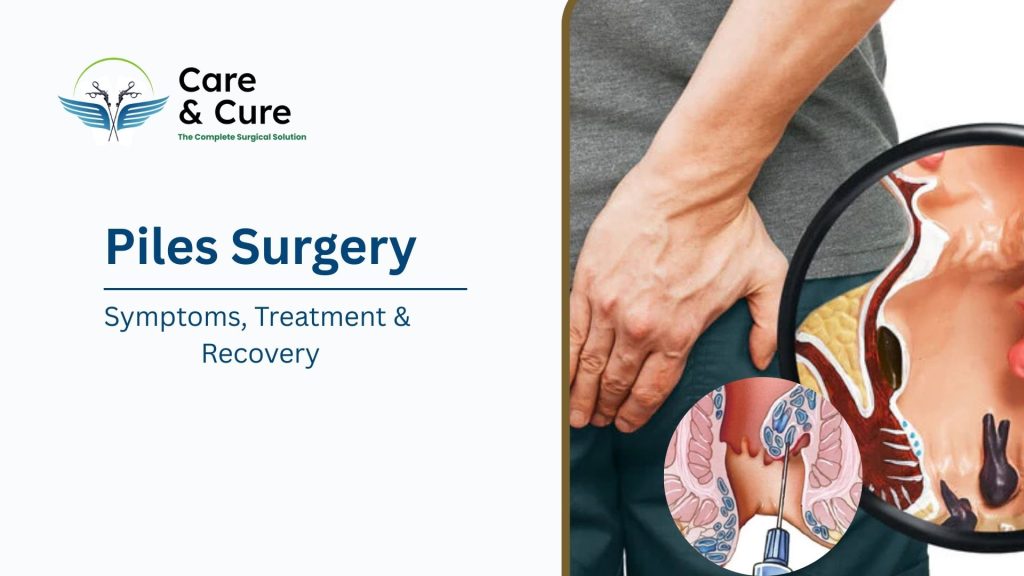
If you’re here reading about piles, it’s probably not because you’re doing a school project — you (or someone you care about) might be dealing with that painful, itchy, annoying situation down there that no one wants to talk about.
As a General and Laparoscopic Surgeon, I see patients all the time who come in looking super uncomfortable, whispering about “some problem in the back.” And the first thing I tell them is: you’re not alone, and there’s absolutely nothing to be embarrassed about.
So let’s break this down together — in a way that’s easy to understand and feels more like a conversation than a medical lecture. Sounds good? Great. Let’s dive in.
What Are Piles, Anyway?
Piles — also called hemorrhoids — are swollen blood vessels in and around your rectum or anus. Think of them like varicose veins, but in a place where, well, sitting becomes a problem when they flare up.
There are two main types:
- Internal piles: These develop inside the rectum and often don’t hurt (but might bleed).
- External piles: These form under the skin around the anus and can cause a lot of discomfort — especially when you sit or go to the toilet.
Sometimes, you might not even realize you have them until you notice some bleeding or feel a little bump. Other times, they’re hard to ignore because of the pain and itching.
👉 Want to dive deeper into the different types of piles and how to tell them apart? Check out this detailed guide here.
What Causes Piles?
Let’s just say your bathroom habits might be partly to blame.
Here are some of the common culprits:
- Chronic constipation or straining during bowel movements – This puts pressure on those blood vessels.
- Sitting for long periods – Desk jobs or long driving hours can contribute.
- Low-fiber diet – Not enough roughage means harder stools.
- Pregnancy – Increased pressure in the pelvis during pregnancy often leads to piles.
- Obesity – Carrying excess weight puts pressure on the veins in your lower body.
Even genetics plays a role! You’re more likely to get them if your parents had them.
Common Symptoms of Piles
Symptoms can vary depending on the type and severity, but here are a few signs to look out for:
- Bright red blood after you go to the toilet (on the paper or in the bowl)
- Itching or irritation in the anal region
- Pain or discomfort, especially when sitting
- Swelling or a lump near your anus (especially with external piles)
- Mucus discharge
If you notice these symptoms, don’t panic — but also, don’t ignore them. It’s always a good idea to check with a doctor.
How Are Piles Diagnosed?
Diagnosis is pretty straightforward and doesn’t take long. Depending on your symptoms, I might do a physical exam or use a small instrument called an anoscope to look inside your rectum.
It might feel a little awkward, but I promise it’s quick and usually painless. The goal is to confirm the presence of piles and rule out any other conditions like fissures or polyps.
Treatment Options (Both Non-Surgical & Surgical)
Non-Surgical Treatments
For mild cases, we usually start with:
- Lifestyle changes – A high-fiber diet, drinking more water, and avoiding straining can make a big difference.
- Topical creams and ointments – These help reduce pain and swelling.
- Warm sitz baths – Soaking the area a few times a day can soothe symptoms.
Some cases might also benefit from rubber band ligation or sclerotherapy, which are minor procedures done without surgery.
Surgical Treatment (When Needed)
If you’ve tried all the above and your symptoms keep coming back (or are severe), surgery might be the best option. There are several types of piles surgeries:
- Hemorrhoidectomy – The traditional method where piles are removed surgically.
- Stapled Hemorrhoidopexy – Less painful and with a quicker recovery.
- Laser or Doppler-guided surgery – Modern, minimally invasive options with faster healing.
The method depends on the grade of piles, your overall health, and personal preferences.
Recovery After Piles Surgery
Recovery isn’t as scary as it sounds. Most patients feel relief within a few days and are back to their routine in a week or two.
Here’s what helps:
- Take your pain meds as prescribed.
- Use stool softeners to avoid straining.
- Keep the area clean and dry.
- Avoid lifting heavy objects or intense workouts for a few weeks.
- Stick to a high-fiber diet to keep things moving smoothly.
Pro tip: Don’t rush back into your normal life. Let your body heal, and be kind to yourself during recovery.
Final Thoughts
Look, dealing with piles isn’t exactly anyone’s idea of a good time. But the good news is — you don’t have to suffer in silence.
Modern treatments, especially surgery, offer excellent results. If your symptoms are affecting your life, it might be time to take the next step and consult a specialist. You deserve to live pain-free, and trust me — the relief after treatment is so worth it.
Got questions? Don’t hesitate to reach out. I’m always here to help.
Until then, take care — and remember, your comfort and health matter more than any temporary embarrassment.
